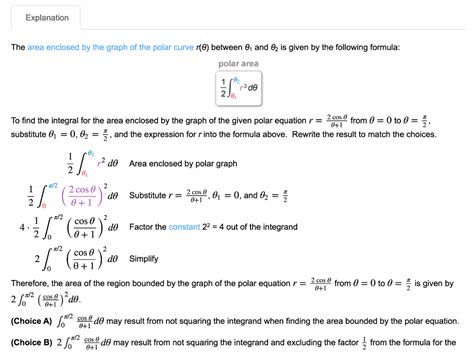Prepare for success on the Calculus BC exam with our comprehensive practice test! This meticulously crafted assessment is designed to thoroughly evaluate your understanding and strengthen your skills in all key areas of the subject.

Section 1: Multiple Choice (60% of Score)
-
The derivative of f(x) = x^3 – 2x is:
(a) 3x^2 – 2
(b) 3x^2 + 2
(c) x^3 – 2
(d) 3x – 2 -
The indefinite integral of ∫(x^2 + 1) dx is:
(a) x^3/3 + x + C
(b) x^2/2 + x + C
(c) x^3 + x + C
(d) x^2 + 1 + C -
The limit of (x^2 – 4)/(x – 2) as x approaches 2 is:
(a) 0
(b) 4
(c) ∞
(d) -∞ -
The derivative of f(x) = ln(x^2 + 1) is:
(a) 2x/(x^2 + 1)
(b) 2/(x^2 + 1)
(c) 1/(x^2 + 1)
(d) x/(x^2 + 1) -
The area under the curve of y = x^2 from x = 0 to x = 2 is:
(a) 4/3
(b) 8/3
(c) 4
(d) 8
Section 2: Free Response (40% of Score)
Part A:
-
Find the critical points of f(x) = x^4 – 4x^2 + 3 and determine whether they are local maxima, local minima, or points of inflection.
-
Evaluate the integral ∫(x*e^x + 1) dx.
-
Find the equation of the tangent line to the curve y = x^3 – 2x^2 + 1 at the point (1, 0).
Part B:
-
A particle moves along a straight line with velocity given by v(t) = t^2 – 2t + 5. Find the position function s(t) and state the time interval during which the particle is moving to the right.
-
A rectangular box with a square base is to be constructed to have a volume of 100 cubic feet. Find the dimensions of the box that minimize the surface area.
-
A spherical balloon is being inflated with air. The radius of the balloon is increasing at a rate of 2 inches per second. Find the rate at which the volume of the balloon is increasing when the radius is 6 inches.
Table 1: Key Calculus BC Concepts
| Concept | Description |
|---|---|
| Limits | Evaluate limits using various techniques |
| Derivatives | Find derivatives of basic and composite functions |
| Integrals | Integrate various types of functions using integral techniques |
| Applications | Apply calculus to solve problems in physics, engineering, and other fields |
| Parametric and Polar Equations | Analyze curves using parametric and polar equations |
Table 2: Effective Strategies for Preparation
| Strategy | Benefit |
|---|---|
| Practice Regularly: Solve practice problems to enhance understanding and identify areas for improvement. | Builds proficiency and reduces anxiety. |
| Study from Multiple Sources: Utilize textbooks, online resources, and tutorials to gain a comprehensive understanding. | Ensures a well-rounded knowledge base. |
| Master Basic Concepts: Prioritize understanding fundamental concepts and formulas before tackling more complex problems. | Provides a solid foundation for advanced topics. |
| Analyze Solutions: Study not only the correct answers but also the step-by-step solutions to learn from mistakes and improve problem-solving skills. | Enhances understanding and prevents repetition of errors. |
| Seek Help When Needed: Don’t hesitate to ask for assistance from teachers, tutors, or classmates when facing challenges. | Overcomes obstacles and accelerates learning. |
Table 3: Common Mistakes to Avoid
| Mistake | Reason |
|---|---|
| Sign Errors: Misplacing negative signs in differentiation or integration. | Leads to incorrect results. |
| Arithmetic Errors: Making mathematical mistakes in calculations. | Affects accuracy. |
| Misapplication of Formulas: Using formulas incorrectly or in inappropriate situations. | Produces invalid results. |
| Neglecting Limits: Failing to evaluate limits or account for discontinuities. | Introduces potential errors. |
| Misinterpreting Graphing Information: Incorrectly identifying key features or interpreting graphs. | Distorts problem analysis. |
Table 4: Pros and Cons of Calculator Use
| Advantage | Disadvantage |
|---|---|
| Faster Calculations: Facilitates complex computations quickly. | May reduce reliance on mental math skills. |
| Accuracy Enhancement: Eliminates human error in numerical calculations. | Can mask fundamental computational weaknesses. |
| Graphic Analysis: Allows for visualization of functions and quick assessment of key features. | May hinder algebraic problem-solving abilities. |
| Time-Saving: Reduces time spent on lengthy calculations, allowing for more problem-solving. | Potential over-reliance on calculator, neglecting computational practice. |
| Challenge Removal: Solves complex problems with ease, potentially reducing critical thinking. | Can become a crutch, hindering problem-solving development. |
Conclusion
Mastering Calculus BC requires consistent practice, a deep understanding of concepts, and effective problem-solving strategies. By engaging with practice tests like the one provided here, you can identify areas for improvement, strengthen your skills, and boost your confidence for the actual exam. Remember to approach your studies with determination and a growth mindset, and you will undoubtedly excel on Calculus BC and unlock doors to future academic and professional opportunities.
